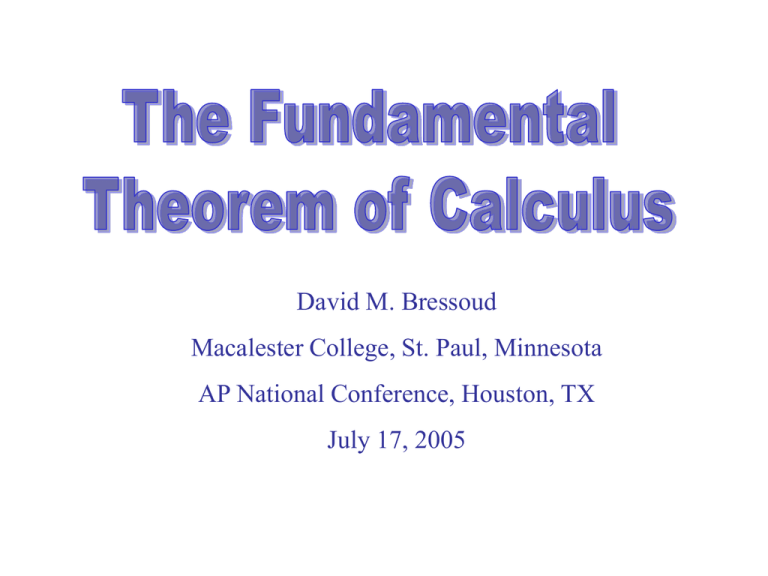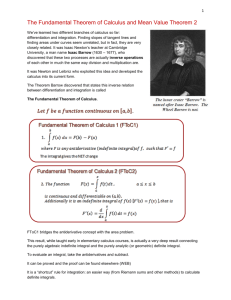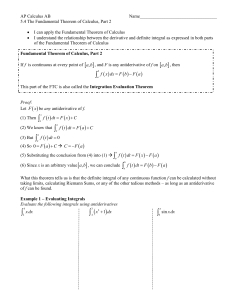
David M. Bressoud
Macalester College, St. Paul, Minnesota
AP National Conference, Houston, TX
July 17, 2005
1. What does the FTC really say: 2004 AB3.
2. Three problems from the 2005 AB exam that
use the FTC.
3. A brief history of the FTC.
This PowerPoint presentation is
available at
www.macalester.edu/~bressoud/talks
2004 AB3(d)
A particle moves along the y-axis so that its velocity v
at time t ≥ 0 is given by v(t) = 1 – tan–1(et). At time t =
0, the particle is at y = –1. Find the position of the
particle at time t = 2.
y '(t) = v(t) = 1 – tan–1(et)
y(t) = ?
Copyright © 2004 by the College Entrance Examination Board. All rights reserved.
Velocity Time = Distance
velocity
time
Areas represent distance moved (positive when v > 0,
negative when v < 0).
v t t
i
v t dt
2
0
This is the total accumulated distance from time t = 0 to t = 2.
Change in y-value equals
y v t dt 1 tan1 et dt 0.367.
0
0
2
2
We now use the fact that y(0) = –1:
y 2 y 0 y 1 0.367 1.367.
The Fundamental Theorem of Calculus (evaluation part):
b
If F' x f x , then
a f xdx Fb Fa .
If y' t v t , then
v t dt y 2 y 0 ,
2
0
y 2 y 0 v t dt.
2
0
The Fundamental Theorem of Calculus (evaluation part):
b
If F' x f x , then
a f xdx Fb Fa .
If y' t v t , then
v t dt y 2 y 0 ,
2
0
y 2 y 0 v t dt.
2
0
If we know an anti-derivative, we can use it to find the
value of the definite integral.
If we know the value of the definite integral, we can use it
to find the change in the value of the anti-derivative.
The Fundamental Theorem of Calculus (evaluation part):
b
If F' x f x , then
a f xdx Fb Fa .
If y' t v t , then
v t dt y 2 y 0 ,
2
0
y 2 y 0 v t dt.
2
0
If we know an anti-derivative, we can use it to find the
value of the definite integral.
If we know the value of the definite integral, we can use it
to find the change in the value of the anti-derivative.
The Fundamental Theorem of Calculus (antiderivative part):
d
dt
v x dx v t
t
0
In other words, 0 v x dx is a perfectly acceptable
antiderivative of v(t).
t
2005 AB3/BC3
Distance
x (cm)
0
1
5
6
8
Temperature
T(x) (°C)
100
93
70
62
55
A metal wire of length 8 centimeters (cm) is heated at one end. The table above gives
selected values of the temperature T(x), in degrees Celsius (°C), of the wire x cm from the
heated end.
8
T ' x dx, and indicate units of measure. Explain the meaning of
(c) Find 0
in terms of the temperature of the wire.
Copyright © 2005 by the College Entrance Examination Board. All rights reserved.
8
0
T ' x dx
2005 AB3/BC3
Distance
x (cm)
0
1
5
6
8
Temperature
T(x) (°C)
100
93
70
62
55
A metal wire of length 8 centimeters (cm) is heated at one end. The table above gives
selected values of the temperature T(x), in degrees Celsius (°C), of the wire x cm from the
heated end.
8
T ' x dx, and indicate units of measure. Explain the meaning of
(c) Find 0
in terms of the temperature of the wire.
8
0
T ' x dx
Evaluation part of FTC:
8
0
T ' x dx T T 8 T 0 55 100 45
This integral represents the change in temperature (in °C) from the heated end of the
wire to the other end.
Copyright © 2005 by the College Entrance Examination Board. All rights reserved.
2005 AB5/BC5
A car is traveling on a straight road. For 0 ≤ t ≤ 24 seconds, the car’s velocity v(t), in meters
per second, is modeled by the piecewise-linear function defined by the graph above.
(a) Find
24
0
v t dt. Using correct units, explain the meaning of
v t dt.
24
0
Copyright © 2005 by the College Entrance Examination Board. All rights reserved.
2005 AB5/BC5
A car is traveling on a straight road. For 0 ≤ t ≤ 24 seconds, the car’s velocity v(t), in meters
per second, is modeled by the piecewise-linear function defined by the graph above.
(a) Find
24
0
v t dt. Using correct units, explain the meaning of
Interpret integral as area (trapezoid):
24
0
v t dt
v t dt.
24
0
12 24
20 360 meters
2
Copyright © 2005 by the College Entrance Examination Board. All rights reserved.
2005 AB5/BC5
A car is traveling on a straight road. For 0 ≤ t ≤ 24 seconds, the car’s velocity v(t), in meters
per second, is modeled by the piecewise-linear function defined by the graph above.
(a) Find
24
0
v t dt. Using correct units, explain the meaning of
Interpret integral as area (trapezoid):
24
0
v t dt
v t dt.
24
0
12 24
20 360 meters
2
Evaluation part of FTC, interpret integral as change in the
antiderivative:
v t dt change in position (in meters) from time t 0 to t 24.
24
0
Copyright © 2005 by the College Entrance Examination Board. All rights reserved.
2005 AB4
The values of f and its first and second derivatives are specified at x = 0,
1, 2, and 3. The sign of f and its derivatives is given for each of the
intervals (0,1), (1,2), (2,3), and (3,4).
(c) Let g be the function defined by g x 1 f t dt on the open interval
(0,4). For 0 < x <4, find all values of x at which g has a relative
extremum. Determine whether g has a relative maximum or a relative
minimum at each of these values. Justify your answer.
x
Copyright © 2005 by the College Entrance Examination Board. All rights reserved.
2005 AB4
The values of f and its first and second derivatives are specified at x = 0,
1, 2, and 3. The sign of f and its derivatives is given for each of the
intervals (0,1), (1,2), (2,3), and (3,4).
(c) Let g be the function defined by g x 1 f t dt on the open interval
(0,4). For 0 < x <4, find all values of x at which g has a relative
extremum. Determine whether g has a relative maximum or a relative
minimum at each of these values. Justify your answer.
x
Antiderivative part of FTC:
d x
g' x
f t dt f x
1
dx
g'' x f ' x
Read information about
derivatives of g from values and
signs of f and its derivative.
Copyright © 2005 by the College Entrance Examination Board. All rights reserved.
There will be many more examples of the
Fundamental Theorem of Calculus in the new
College Board Professional Development
package which should be available this year.
Richard Courant, Differential
and Integral Calculus (1931),
first calculus textbook to state
and designate the
Fundamental Theorem of
Calculus in its present form.
Richard Courant, Differential
and Integral Calculus (1931),
first calculus textbook to state
and designate the
Fundamental Theorem of
Calculus in its present form.
FTC in present form does not appear in most commonly
used calculus texts until George Thomas’s Calculus in the
1950s.
1630’s Descartes, Fermat, and others discover general
rule for slope of tangent to a polynomial.
René Descartes (1596–1650)
Pierre de Fermat (1601–1665)
1630’s Descartes, Fermat, and others discover general
rule for slope of tangent to a polynomial.
Amazingly, these are inverse to the long known
formulas of quadrature (finding areas):
Archimedes (287–212 BC)
al-Haytham (965–1039)
Levi ben Gerson (1288–1344)
Johannes Kepler (1571–1630)
1630’s Descartes, Fermat, and others discover general
rule for slope of tangent to a polynomial.
1639, Descartes describes reciprocity in letter to
DeBeaune
Hints of the reciprocity result in studies of integration by
Wallis (1658), Neile (1659), and Gregory (1668)
John Wallis (1616–1703)
James Gregory (1638–1675)
First published proof by Barrow (1670)
Isaac Barrow (1630–1677)
Discovered by Newton (1666, unpublished); and by
Leibniz (1673)
Isaac Newton (1643–1727)
Gottfried Leibniz (1646–1716)
Wm. A. Granville, Pennsylvania (Gettysburg)
College, Elements of the Differential and Integral
Calculus, 1904, 1911, 1941
“The problems of the Integral Calculus depend on the
inverse operation, namely:
To find a function f (x) whose derivative
A
is given.”
f ' x x
Wm. A. Granville, Pennsylvania (Gettysburg)
College, Elements of the Differential and Integral
Calculus, 1904, 1911, 1941
“Theorem. The difference of the values of ydx
for x = a and x = b gives the area bounded by the curve
whose ordinate is y, the axis of X, and the ordinates
corresponding to x = a and x = b.
This difference is represented by the symbol
I
b
a
ydx, or,
x dx,
b
a
and is read ‘the integral from a to b of ydx.’ ”
The Problem:
This is how most students think of integration, as the
inverse of differentiation. They think of a definite integral
as the difference of the antiderivative evaluated at the two
endpoints.
The FTC does not look like a theorem to them. It
looks like a definition.
The Solution:
Emphasize the usefulness of the limit definition of
the definite integral (e.g. as what graphing calculators use to
approximate integrals).
Emphasize the connection that FTC establishes
between antidifferentiation and area or total change.
What if a function is not the
derivative of some identifiable
function?
x 2
e
What if a function is not the
derivative of some identifiable
function?
x 2
e
Joseph Fourier (1807): Put the emphasis
on definite
b
integrals (he invented the notation a ) and defined
them in terms of area between graph and x-axis.
What if a function is not the
derivative of some identifiable
function?
x 2
e
Joseph Fourier (1807): Put the emphasis
on definite
b
integrals (he invented the notation a ) and defined
them in terms of area between graph and x-axis.
How do you define area?
A.-L. Cauchy: First to define
the integral as the limit of the
summation
f xi 1 xi xi1
Also the first (1823) to explicitly state and prove the
antiderivative part of the FTC when f is continuous:
d x
f t dt f x .
a
dx
Bernhard Riemann (1852, 1867) On the representation
of a function as a trigonometric series
b
Defined a
f
x
f xdx as limit of i xi xi1
Bernhard Riemann (1852, 1867) On the representation
of a function as a trigonometric series
b
Defined a
f
x
f xdx as limit of i xi xi1
When is a function
integrable?
Does the Fundamental
Theorem of Calculus
always hold?
The Fundamental Theorem of Calculus
(antiderivative part):
d x
f
t
dt
f
x
.
dx a
Riemann found an example of a function f that is
integrable over any interval but whose antiderivative is
not differentiable at x if x is a rational number with an
even denominator.
The Fundamental Theorem of Calculus
(evaluation part):
b
If F' x f x , then a f xdx Fb Fa .
The Fundamental Theorem of Calculus
(evaluation part):
b
If F' x f x , then a f xdx Fb Fa .
Vito Volterra, 1881, found
a bounded function f with
an anti-derivative F so that
F'(x) = f(x) for all x, but
there is no interval over
which the definite integral
of f(x) exists.
Henri Lebesgue, 1901,
came up with a totally
different way of
defining integrals that is
the same as the
Riemann integral for
nice functions, but that
avoids the problems
with the Fundamental
Theorem of Calculus.
d 2
f x
x sin 1 x
dx
2x sin 1 x cos 1 x
d 2
f x
x sin 1 x
dx
2x sin 1 x cos 1 x
d 2
f x
x sin 1 x
dx
2x sin 1 x cos 1 x
d 2
f x
x sin 1 x
dx
2x sin 1 x cos 1 x
d 2
f x
x sin 1 x
dx
2x sin 1 x cos 1 x
d 2
f x
x sin 1 x
dx
2x sin 1 x cos 1 x
Antiderivative part of FTC (Lebesgue 1904):
If f is integrable (in the Lebesgue sense) on [a, b], then
d x
f t dt f x
dx a
almost everywhere on [a, b].
Antiderivative part of FTC (Lebesgue 1904):
If f is integrable (in the Lebesgue sense) on [a, b], then
d x
f t dt f x
dx a
almost everywhere on [a, b].
The set of x for which this does not hold can be
contained in a countable union of intervals, the
sum of whose lengths is as small as desired
Evaluation part of FTC (Lebesgue 1904):
If f is absolutely continuous on [a, b], then f is differentiable almost
everywhere on [a, b], the derivative of f is integrable (in the Lebesgue
sense), and
f 't dt f x f a
x
a
for all x in [a, b].
Evaluation part of FTC (Lebesgue 1904):
If f is absolutely continuous on [a, b], then f is differentiable almost
everywhere on [a, b], the derivative of f is integrable (in the Lebesgue
sense), and
f 't dt f x f a
x
a
for all x in [a, b].
Given any > 0, there exists a response so that for any collection
n
of pairwise disjoint intervals ak ,bk k 1 , the sum of whose lengths is
less the , the sum of the changes in the values of functions over
these intervals will be less than : n
f bk f ak .
k 1
This PowerPoint presentation is
available at
www.macalester.edu/~bressoud/talks
Now working on a new text, The Fundamental
Theorem of Calculus, for the MAA.








